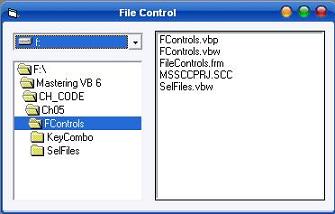- DriveListBox : Displays the names of the drives within and connected to the PC. The basic property of this control is the drive property, which set the drive to be initially selected in the control or returns the user's selection.
- DirListBox : Displays the folders of current Drive. The basic property of this control is the Path property, which is the name of the folder whose sub folders are displayed in the control.
- FileListBox : Displays the files of the current folder. The basic property of this control is also called Path, and it's the path name of the folder whose files are displayed.
The three File controls are not tied to one another. If you place all three of them on a Form, you will see the names of all the folders under the current folder, and so on. Each time you select a folder in the DirlistBox by double clicking its name, its sub folders are displayed. Similarly , the FileListBox control will display the names of all files in the current folder. Selecting a drive in the DriveListBox control, however this doesn't affect the contents of the DirListBox.
To connect to the File controls, you must assign the appropriate values to the properties. To compel the DirListBox to display the folders of the selected drive in the DriveListBox, you must make sure that each time the user selects another drive, the Path property of the DirListBox control matches the Drive property of the DriveListBox.
After these preliminary steps, you're ready to set in motion the chain of events. When the user selects a new drive in the DriveListBox control, it fires a Change event and returns the drive letter (and volume label) in its Drive property. You trap this event and set the DirListBox control's Path property to point to the root directory of the selected drive:
Private Sub Drive1_Change()
' The Drive property also returns the volume label, so trim it.
Dir1.Path = Left$(Drive1.Drive, 1) & ":\"
End Sub
' The Drive property also returns the volume label, so trim it.
Dir1.Path = Left$(Drive1.Drive, 1) & ":\"
End Sub
When the user double-clicks on a directory name, the DirListBox control raises a Change event; you trap this event to set the FileListBox's Path property accordingly:
Private Sub Dir1_Change()
File1.Path = Dir1.Path
End Sub
File1.Path = Dir1.Path
End Sub
Finally, when the user clicks on a file in the FileListBox control, a Click event is fired (as if it were a regular ListBox control), and you can query its Filename property to learn which file has been selected. Note how you build the complete path:
Filename = File1.Path
If Right$(Filename, 1) <> "\" Then Filename = Filename & "\"
Filename = Filename & File1.Filename
If Right$(Filename, 1) <> "\" Then Filename = Filename & "\"
Filename = Filename & File1.Filename
The DirListBox and FileListBox controls support most of the properties typical of the control they derive from—the ListBox control—including the ListCount and the ListIndex properties and the Scroll event. The FileListBox control supports multiple selection; hence you can set its MultiSelect property in the Properties window and query the SelCount and Selected properties at run time.
The FileListBox control also exposes a few custom Boolean properties, Normal, Archive, Hidden, ReadOnly, and System, which permit you to decide whether files with these attributes should be listed. (By default, the control doesn't display hidden and system files.) This control also supports a couple of custom events, PathChange and PatternChange, that fire when the corresponding property is changed through code. In most cases, you don't have to worry about them, and I won't provide examples of their usage.
The problem with the DriveListBox, DirListBox and FileListBox controls is that they're somewhat outdated and aren't used by most commercial applications any longer. Moreover, these controls are known to work incorrectly when listing files on network servers and sometimes even on local disk drives, especially when long file and directory names are used. For this reason, I discourage you from using them and suggest instead that you use the Common Dialog controls for your FileOpen and FileSave dialog boxes. But if you need to ask the user for the name of a directory rather than a file, you're out of luck because—while Windows does include such a system dialog box, named BrowseForFolders dialog—Visual Basic still doesn't offer a way to display it (unless you do some advanced API programming). Fortunately, Visual Basic 6 comes with a new control—the ImageCombo control—that lets you simulate the appearance of the DriveListBox control. It also offers you a powerful library—the FileSystemObject library—that completely frees you from using these three controls, if only as hidden controls that you use just for quickly retrieving information on the file system.

0 comments:
Post a Comment